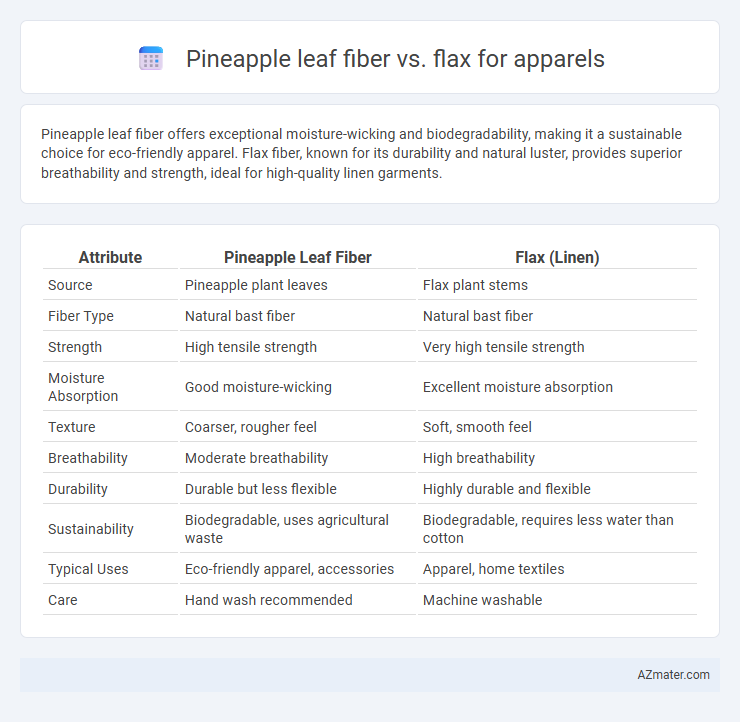Pineapple leaf fiber offers exceptional moisture-wicking and biodegradability, making it a sustainable choice for eco-friendly apparel. Flax fiber, known for its durability and natural luster, provides superior breathability and strength, ideal for high-quality linen garments.
Table of Comparison
| Attribute | Pineapple Leaf Fiber | Flax (Linen) |
|---|---|---|
| Source | Pineapple plant leaves | Flax plant stems |
| Fiber Type | Natural bast fiber | Natural bast fiber |
| Strength | High tensile strength | Very high tensile strength |
| Moisture Absorption | Good moisture-wicking | Excellent moisture absorption |
| Texture | Coarser, rougher feel | Soft, smooth feel |
| Breathability | Moderate breathability | High breathability |
| Durability | Durable but less flexible | Highly durable and flexible |
| Sustainability | Biodegradable, uses agricultural waste | Biodegradable, requires less water than cotton |
| Typical Uses | Eco-friendly apparel, accessories | Apparel, home textiles |
| Care | Hand wash recommended | Machine washable |
Overview of Pineapple Leaf Fiber and Flax
Pineapple leaf fiber (PALF) is a strong, coarse natural fiber extracted from the leaves of the pineapple plant, valued for its durability and biodegradability in apparel production. Flax fiber, derived from the flax plant, is renowned for its lightweight, smooth texture and excellent moisture-wicking properties, making it highly suitable for breathable clothing. Both fibers offer sustainable alternatives to synthetic textiles, with PALF providing greater stiffness and strength, while flax delivers superior softness and flexibility.
Historical Applications in Textiles
Pineapple leaf fiber has been historically used in traditional Filipino textiles like pina fabric, prized for its lightweight and translucent qualities ideal for formal attire. Flax fibers, derived from the flax plant, have been cultivated since ancient Egyptian times for linen, renowned for durability, breathability, and moisture-wicking properties in apparel. Both fibers offer unique texture and sustainability profiles, with flax dominating European textile history and pineapple leaf fibers integral to Southeast Asian heritage fabrics.
Fiber Extraction and Processing Methods
Pineapple leaf fiber extraction involves a decortication process where leaves are crushed and scraped to separate fibers, followed by washing and drying to enhance fiber quality. Flax fiber extraction uses retting, a microbial or chemical process that breaks down pectin to free fibers, combined with scutching and hackling to refine the fiber for textile use. Processing pineapple leaf fibers typically requires less water and chemical input compared to flax, offering a more sustainable method while flax fibers often yield finer yarns suitable for premium apparel.
Physical and Mechanical Properties Comparison
Pineapple leaf fiber exhibits higher tensile strength and stiffness compared to flax, making it suitable for durable apparel applications. Flax offers superior flexibility and moisture absorption, enhancing comfort in wearable textiles. Both fibers possess natural biodegradability, but pineapple leaf fiber's coarser texture requires blending or processing for softer fabric finishes.
Sustainability and Environmental Impact
Pineapple leaf fiber, derived from agricultural waste, offers a highly sustainable alternative to flax by reducing landfill waste and requiring minimal water and pesticides compared to flax cultivation. Flax fiber, although biodegradable and renewable, necessitates intensive water use and chemical retting processes that can harm aquatic ecosystems. Choosing pineapple leaf fiber for apparels significantly lowers environmental impact through waste valorization and eco-friendly production practices.
Comfort and Wearability in Apparel
Pineapple leaf fiber offers exceptional breathability and moisture-wicking properties, making it highly comfortable for warm-weather apparel. Flax fiber, known for its durability and smooth texture, provides a lightweight feel with excellent thermal regulation suitable for both warm and cool climates. Both fibers are sustainable options, but pineapple leaf fiber typically enhances wearability in casual and activewear due to its natural softness and flexibility.
Dyeing and Finishing Capabilities
Pineapple leaf fiber offers excellent dye absorption due to its high cellulose content and natural brightness, enabling vibrant color retention in apparel. Flax fibers provide superior moisture-wicking properties during dyeing, supporting even color distribution and durability in finished garments. Both fibers respond well to eco-friendly finishing treatments, but flax typically achieves a softer hand feel post-finishing compared to the slightly coarser texture of pineapple leaf fiber.
Market Availability and Cost Factors
Pineapple leaf fiber (PALF) and flax are both sustainable fibers used in apparel, but flax dominates the market with broader availability and established supply chains, especially in Europe and North America. PALF, sourced primarily from Southeast Asia, remains niche with limited processing infrastructure, leading to higher production costs and less price competitiveness. The cost factors for flax benefit from mature technology and scale, making it more affordable for mainstream apparel manufacturers compared to the relatively expensive and less accessible PALF.
Innovations and Future Trends
Pineapple leaf fiber (PALF) and flax are emerging sustainable textiles gaining traction in apparel innovation due to their eco-friendly cultivation and biodegradability. Advances in fiber extraction technology and blending techniques enhance PALF's softness and durability, making it a competitive alternative to flax, traditionally prized for its linen production and breathability. Future trends indicate increased integration of bio-based treatments and smart textile functionalities in both fibers, positioning them at the forefront of sustainable fashion and performance apparel markets.
Consumer Perception and Brand Adoption
Pineapple leaf fiber is gaining consumer interest due to its sustainability and natural origin, often perceived as an eco-friendly alternative to traditional fabrics in apparel markets. Flax, widely known for producing linen, enjoys established brand adoption thanks to its durability, breathability, and premium texture favored by designers and consumers alike. Brands are increasingly adopting pineapple leaf fiber to appeal to environmentally conscious consumers seeking innovative, biodegradable textiles, while flax maintains strong appeal for its heritage and performance in luxury apparel segments.

Infographic: Pineapple leaf fiber vs Flax for Apparels
 azmater.com
azmater.com